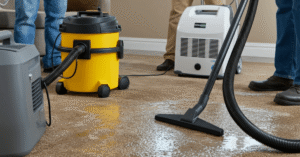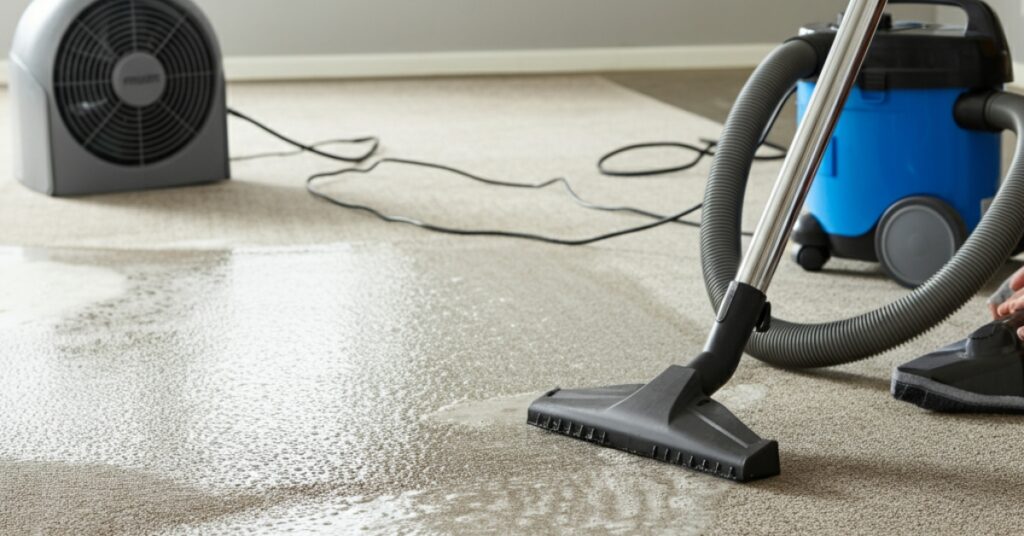As an Amazon Associate, I earn from qualifying purchases.
Discovering coconut oil on your carpet can feel overwhelming, but removing it is simpler than you might think. Learning how to get coconut oil out of carpet effectively prevents permanent staining and keeps your flooring looking fresh. Coconut oil solidifies at room temperature but melts quickly, creating greasy spots that penetrate deep into carpet fibers.
Quick action makes all the difference when dealing with coconut oil spills. The longer the oil sits, the deeper it soaks into your carpet, making removal more challenging. However, with the right approach and common household items, you can eliminate these stubborn stains completely. This guide walks you through proven methods that break down the oil and restore your carpet’s appearance.
What Makes Coconut Oil Difficult to Remove
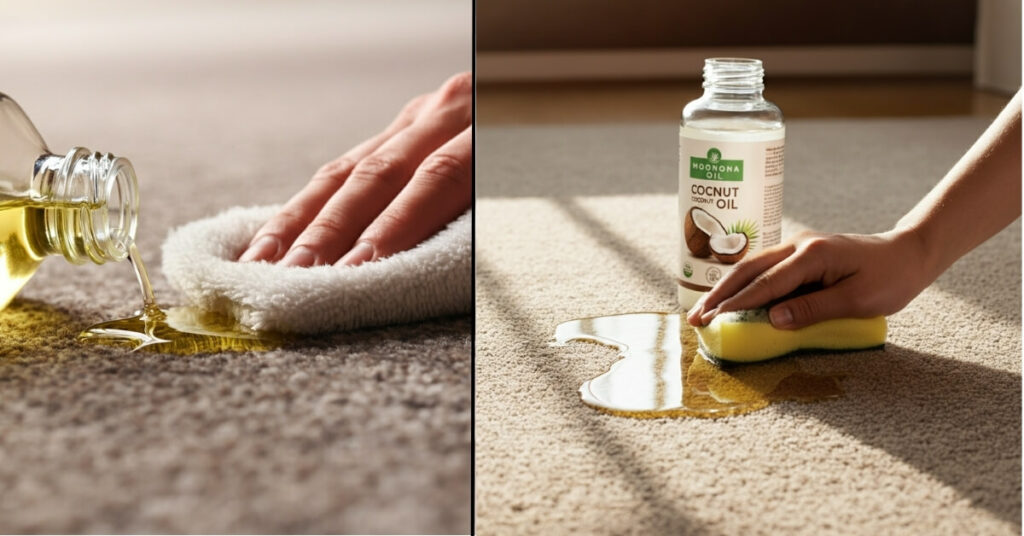
Coconut oil presents unique cleaning challenges due to its molecular structure and behavior at different temperatures. Unlike water-based spills that stay on the surface, coconut oil has a low melting point of around 76°F, which means it quickly liquefies from body heat or warm room temperatures. Once liquid, it penetrates carpet fibers rapidly and can reach the backing material.
The oil’s composition also makes it resistant to water-based cleaning methods alone. Coconut oil contains saturated fats that don’t dissolve easily in water, requiring specific techniques to break down the greasy residue. Additionally, if left untreated, the oil attracts dirt and dust particles, creating dark, noticeable stains that become increasingly difficult to remove over time.
Why Acting Fast Matters
Time is critical when addressing coconut oil spills on carpet. Fresh spills remain closer to the surface, making them easier to lift out completely. Within the first few minutes, you can still remove much of the oil through simple blotting techniques. However, as time passes, the oil migrates deeper into the carpet pile and can even reach the padding underneath.
Furthermore, delayed treatment allows the oil to oxidize and become more chemically stable, making it harder to dissolve with standard cleaning solutions. Quick action also prevents the stain from spreading to surrounding carpet areas, keeping the affected zone contained and manageable.
Essential Supplies for Coconut Oil Removal
Gathering the right materials before you begin ensures efficient stain removal without interruption. Most effective coconut oil removal techniques use common household items that you likely already own. Having everything ready allows you to work quickly, which significantly improves your success rate.
You’ll need several absorbent materials including paper towels, clean white cloths, and cornstarch or baking soda. Additionally, collect a dull knife or spoon for scraping, mild dish soap, warm water, and a small bowl for mixing cleaning solutions. Keep a vacuum cleaner nearby for the final cleanup stages.
Choosing the Right Cleaning Agents
Selecting appropriate cleaning agents makes the difference between successful stain removal and damage to your carpet. Mild dish soap works exceptionally well because manufacturers design it specifically to cut through grease and oil. Always choose clear, uncolored dish soap to avoid transferring dyes to your carpet fibers.
Cornstarch and baking soda serve as excellent absorbent powders that draw oil out of carpet fibers naturally. These powders work through capillary action, pulling the oil molecules up and away from the carpet backing. White vinegar can also help in the final stages by breaking down soap residue and neutralizing any remaining grease.
Initial Cleanup Techniques
Starting with proper initial cleanup prevents the stain from spreading and removes the bulk of the coconut oil before deep cleaning begins. This phase focuses on physical removal rather than chemical treatment, making subsequent cleaning steps more effective.
The key is working gently to avoid pushing the oil deeper into the carpet pile. Aggressive scrubbing or pressing can force the oil through the carpet backing, making complete removal nearly impossible.
Scraping Away Solid Coconut Oil
Begin by removing any solid coconut oil using a dull knife, spoon, or credit card edge. Work carefully around the affected area, lifting away chunks without pressing them into the carpet. If the oil has hardened completely, you might need to warm it slightly with a hair dryer on low heat to make scraping easier.
Collect the scraped oil on a paper towel rather than letting it fall onto clean carpet areas. Continue until you’ve removed all visible solid oil, leaving only the absorbed liquid portion in the carpet fibers. This step eliminates the majority of the oil and prevents it from re-melting and spreading during the cleaning process.
Effective Blotting Methods
Once you’ve removed the solid oil, immediately blot the remaining liquid using clean, dry paper towels or white cloth. Press firmly straight down onto the stain, allowing the absorbent material to soak up the oil. Lift the towel straight up rather than wiping, which can spread the stain to clean areas.
Replace the paper towel or move to a clean section of cloth frequently, continuing until no more oil transfers to the absorbent material. This process might take several rounds, but persistence pays off by removing significant amounts of oil before you begin wet cleaning methods.
How to Get Coconut Oil Out of Carpet Using Absorption Methods
Absorption methods work by drawing oil out of carpet fibers using materials with high absorptive capacity. These techniques are particularly effective for coconut oil because they target the greasy components specifically without adding moisture that could spread the stain.
The science behind absorption involves capillary action and molecular attraction. Absorbent powders create microscopic spaces that trap oil molecules, pulling them away from carpet fibers and into the powder particles instead.
Applying Cornstarch Treatment
Generously sprinkle cornstarch over the entire stained area, ensuring complete coverage of the affected carpet. The powder needs direct contact with the oil to work effectively, so press it gently into the carpet pile using your fingers or a clean cloth. Don’t rub or grind the powder in, as this can damage carpet fibers.
Allow the cornstarch to sit undisturbed for at least 30 minutes, though longer treatment times improve results for heavy stains. During this waiting period, the cornstarch draws oil molecules out of the carpet through natural absorption processes. For particularly stubborn stains, leave the powder in place for up to two hours before removal.
Vacuuming the Treated Area
After the cornstarch has had sufficient time to absorb the oil, thoroughly vacuum the entire treated area. Use slow, overlapping passes to ensure you remove all the powder along with the absorbed oil. Empty your vacuum bag or canister afterward, as the oil-saturated powder can create unpleasant odors if left inside.
Check the carpet carefully after vacuuming to see if any stain remains visible. If you still notice greasy spots, repeat the cornstarch treatment once more before moving on to liquid cleaning methods. Multiple absorption treatments often prove more effective than rushing into wet cleaning techniques.
Liquid Cleaning Solutions
After absorption methods have removed the bulk of the oil, liquid cleaning solutions target any remaining greasy residue embedded in carpet fibers. These solutions work by breaking down oil molecules chemically, making them easier to lift away from the carpet.
The key to successful liquid cleaning lies in using the right concentration of cleaning agents and controlling moisture levels to prevent over-wetting the carpet backing.
Creating an Effective Dish Soap Solution
Mix one teaspoon of clear, mild dish soap with one cup of warm water in a small bowl. Stir gently to dissolve the soap without creating excessive foam, which can make rinsing more difficult later. The warm water helps activate the soap’s grease-cutting properties while remaining gentle on carpet fibers.
Test this solution on an inconspicuous carpet area first to ensure it doesn’t cause discoloration or damage. Most carpets handle mild dish soap well, but certain delicate fibers or dyes might react poorly to cleaning agents.
Applying the Cleaning Solution
Dip a clean white cloth into the soap solution and wring out excess moisture until the cloth is damp but not dripping. Gently dab the stained area, working from the outside edges toward the center to prevent spreading. This technique contains the stain while allowing the soap to penetrate the remaining oil.
Continue dabbing with clean sections of the cloth, re-dipping in the solution as needed. You should notice the remaining oil dissolving and transferring to the cloth. Avoid scrubbing motions, which can damage carpet fibers and work the stain deeper into the backing material.
Rinsing and Final Cleanup
Proper rinsing removes soap residue that could attract dirt and make your carpet appear dingy over time. This phase requires careful moisture control to clean the carpet thoroughly without causing water damage or promoting mold growth.
The rinsing process also helps restore the carpet’s natural texture and appearance after the cleaning treatment.
Removing Soap Residue
Create a rinse solution using clean water in a separate bowl. Dip a fresh white cloth in the water and wring it out until barely damp. Gently blot the cleaned area to remove soap residue, working systematically across the entire treated zone.
Change the rinse water and use clean cloth sections frequently to avoid redistributing soap back onto the carpet. Continue until the cloth comes away clean, indicating that all soap residue has been removed from the carpet fibers.
Thorough Drying Process
Place several layers of clean, dry towels over the damp carpet area and press down firmly to absorb remaining moisture. Stand on the towels or apply pressure with your hands to maximize water absorption. Replace saturated towels with dry ones until no more moisture transfers.
Position a fan near the cleaned area or open windows to improve air circulation and speed drying. Complete drying typically takes several hours, depending on humidity levels and air movement. Once fully dry, vacuum the area again to restore the carpet’s natural texture and remove any remaining particles.
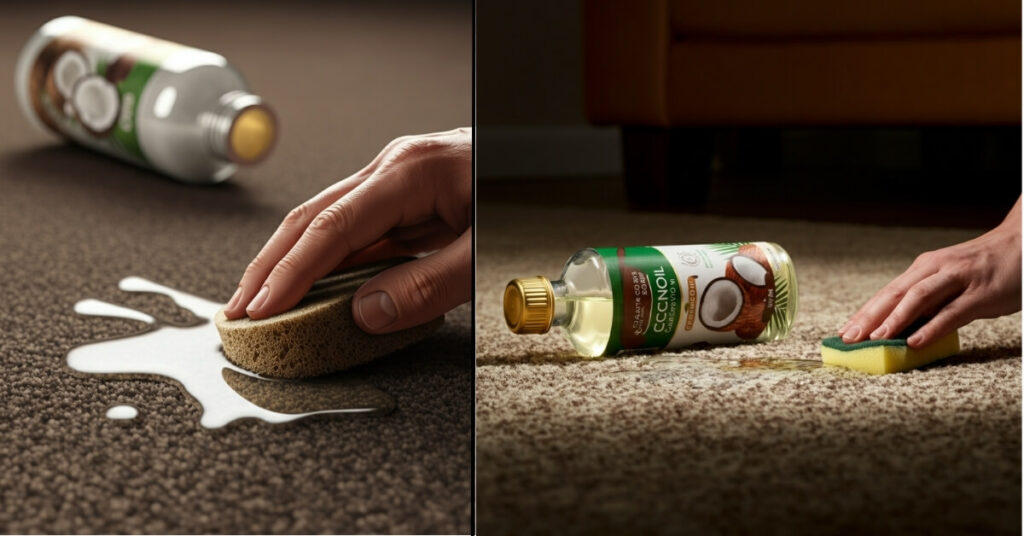
Frequently Asked Questions
1. Can baking soda remove coconut oil from carpet?
Yes, baking soda works similarly to cornstarch by absorbing oil from carpet fibers. Apply it generously over the stain, let it sit for 30-60 minutes, then vacuum thoroughly. Baking soda also helps neutralize odors that might accompany the oil stain.
2. Will heat help remove coconut oil stains?
Heat can help, but use it carefully. Place a brown paper bag over the stain and use a warm iron on low heat without steam. The heat melts the oil, which transfers to the paper. However, too much heat can damage synthetic carpet fibers.
3. How long does it take to remove coconut oil from carpet?
Complete removal typically takes 2-4 hours, including treatment time and drying. Fresh spills clean up faster than set-in stains. The absorption phase requires 30-60 minutes, followed by liquid cleaning and several hours of drying time.
4. Can professional carpet cleaning remove old coconut oil stains?
Yes, professional cleaners have specialized equipment and solutions that can tackle set-in coconut oil stains. They use hot water extraction and commercial-grade degreasers that aren’t available to consumers.
5. What should I avoid when cleaning coconut oil from carpet?
Avoid using hot water initially, as it can set the stain permanently. Don’t rub or scrub the stain, which spreads it further. Never use bleach-based cleaners on colored carpets, and avoid over-wetting the carpet backing.
Successfully Restore Your Carpet
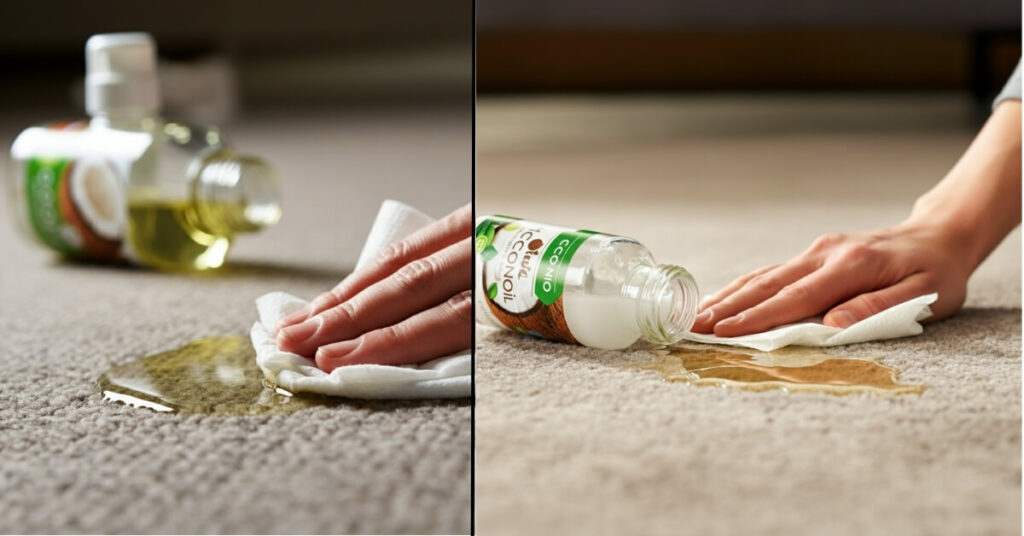
Removing coconut oil from carpet becomes manageable when you follow the right sequence of techniques. Start with physical removal and absorption methods before progressing to liquid cleaning solutions. Each step builds on the previous one, systematically breaking down and removing the oil until your carpet looks fresh again.
Remember that patience and proper technique matter more than aggressive scrubbing. By understanding how to get coconut oil out of carpet effectively, you can handle future spills with confidence. Keep the necessary supplies on hand, and don’t hesitate to act quickly when accidents happen. Your carpet will thank you for the careful attention and proper treatment.
As an Amazon Associate, I earn from qualifying purchases.

